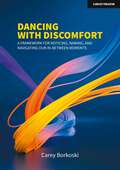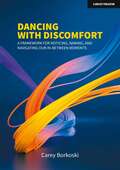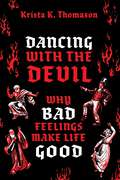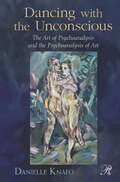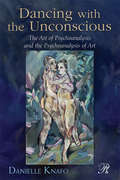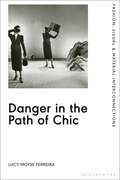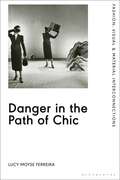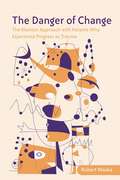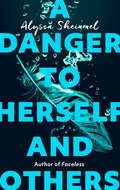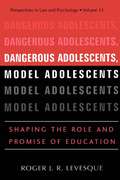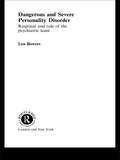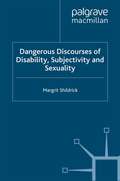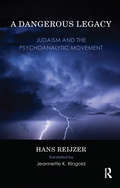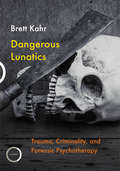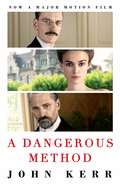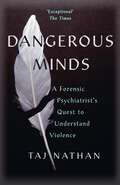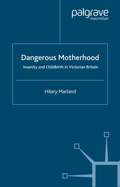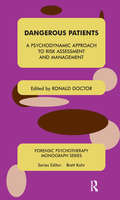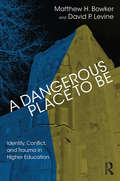- Table View
- List View
Dancing with Discomfort: A framework for noticing, naming, and navigating our in-between moments
by Carey BorkoskiTransitions are universal. They include the important and familiar milestones of starting kindergarten, graduating from high school or college, and becoming employed, parents, or retirees. These transitional moments, however, also include unexpected or unanticipated events like losing a job, joining a running club, or experiencing a global pandemic. In each of these moments, individuals, groups, and organizations experience the anxiety, self-doubt, worry, and uncertainty associated with these novel experiences. Our natural response to these moments is to avoid, side-step, or hurry through until this moment of transition is over. The problem with these strategies is that while we are trying to shut out the unpleasant feelings of those moments, we also miss all the possibilities and discovery. What if we invested time, training, and space to learn, experiment with and strengthen our ability to wrestle with and successfully navigate these moments of transition? Whether a significant transition like moving into a new school or just shifting from one project to the next, we need to build strategies and techniques to leverage and learn from the discomfort that individuals experience during these moments. This book offers names and faces for our feelings, thoughts, and reactions in our transitions. It is based on sound research and data collected by the author and other researchers but is also based on the author’s experiences, mistakes, reflection, and learning from doing the work in different contexts. It includes a framework to learn to stay in these transitions, embrace dissonance, and leverage these moments of discovery. Whether you want to introduce this transitions framework and strategies in a classroom, boardroom, or your own life, this book is for you and your organization to start the intentional work to create spaces, and time to name, feel, explore, reflect on, and move through the myriad transitions occurring during our personal and professional journeys.
Dancing with Discomfort: A framework for noticing, naming, and navigating our in-between moments
by Carey BorkoskiTransitions are universal. They include the important and familiar milestones of starting kindergarten, graduating from high school or college, and becoming employed, parents, or retirees. These transitional moments, however, also include unexpected or unanticipated events like losing a job, joining a running club, or experiencing a global pandemic. In each of these moments, individuals, groups, and organizations experience the anxiety, self-doubt, worry, and uncertainty associated with these novel experiences. Our natural response to these moments is to avoid, side-step, or hurry through until this moment of transition is over. The problem with these strategies is that while we are trying to shut out the unpleasant feelings of those moments, we also miss all the possibilities and discovery. What if we invested time, training, and space to learn, experiment with and strengthen our ability to wrestle with and successfully navigate these moments of transition? Whether a significant transition like moving into a new school or just shifting from one project to the next, we need to build strategies and techniques to leverage and learn from the discomfort that individuals experience during these moments. This book offers names and faces for our feelings, thoughts, and reactions in our transitions. It is based on sound research and data collected by the author and other researchers but is also based on the author's experiences, mistakes, reflection, and learning from doing the work in different contexts. It includes a framework to learn to stay in these transitions, embrace dissonance, and leverage these moments of discovery. Whether you want to introduce this transitions framework and strategies in a classroom, boardroom, or your own life, this book is for you and your organization to start the intentional work to create spaces, and time to name, feel, explore, reflect on, and move through the myriad transitions occurring during our personal and professional journeys.
Dancing with the Devil: Why Bad Feelings Make Life Good
by Krista K. ThomasonJust as a garden needs worms, we need bad feelings.... We tend to think about bad feelings--feelings like anger, envy, spite, and contempt--as the weeds in life's garden. You may not be able to get rid of them completely, but you're supposed to battle them as best you can. The best garden is one with no weeds. The best life is one with no bad feelings. But this isn't quite right, according to philosopher Krista K. Thomason. Bad feelings are the worms, not the weeds. They're just below the surface, and we like to pretend they aren't there, but they serve an important purpose. Worms are just as much a part of the garden as the flowers, and their presence means your garden is thriving. Gardens aren't better off without their worms, and neither are we. The trick is learning how to enjoy our gardens, worms and all. Thomason draws on insights from the history of philosophy to show what we've gotten wrong about bad feelings and to show readers how we can live better with them. There is nothing wrong with negative emotions per se. Their bad reputation is undeserved. Negative emotions are expressions of self-love--not egoism or selfishness, but the felt attachment to ourselves and to our lives. We feel negative emotions because our lives matter to us. After explaining this, Thomason helps us look at individual bad feelings: anger, envy and jealousy, spite and Schadenfreude, and contempt. As she demonstrates in this tour of negative emotions, these feelings are valuable parts of our attachment to our lives. We don't have to battle negative emotions or "channel" them into something productive. Bad feelings aren't obstacles to a good life; they are part of what makes life meaningful.
Dancing with the Devil: Why Bad Feelings Make Life Good
by Krista K. ThomasonJust as a garden needs worms, we need bad feelings.... We tend to think about bad feelings--feelings like anger, envy, spite, and contempt--as the weeds in life's garden. You may not be able to get rid of them completely, but you're supposed to battle them as best you can. The best garden is one with no weeds. The best life is one with no bad feelings. But this isn't quite right, according to philosopher Krista K. Thomason. Bad feelings are the worms, not the weeds. They're just below the surface, and we like to pretend they aren't there, but they serve an important purpose. Worms are just as much a part of the garden as the flowers, and their presence means your garden is thriving. Gardens aren't better off without their worms, and neither are we. The trick is learning how to enjoy our gardens, worms and all. Thomason draws on insights from the history of philosophy to show what we've gotten wrong about bad feelings and to show readers how we can live better with them. There is nothing wrong with negative emotions per se. Their bad reputation is undeserved. Negative emotions are expressions of self-love--not egoism or selfishness, but the felt attachment to ourselves and to our lives. We feel negative emotions because our lives matter to us. After explaining this, Thomason helps us look at individual bad feelings: anger, envy and jealousy, spite and Schadenfreude, and contempt. As she demonstrates in this tour of negative emotions, these feelings are valuable parts of our attachment to our lives. We don't have to battle negative emotions or "channel" them into something productive. Bad feelings aren't obstacles to a good life; they are part of what makes life meaningful.
Dancing with the Unconscious: The Art of Psychoanalysis and the Psychoanalysis of Art (Psychoanalysis in a New Key Book Series)
by Danielle KnafoIn writing and lecturing over the past two decades on the relationship between psychoanalysis and art, Danielle Knafo has demonstrated the many ways in which these two disciplines inform and illuminate each other. This book continues that discussion, emphasizing how the creative process in psychoanalysis and art utilizes the unconscious in a quest for transformation and healing. Part one of the book presents case studies to show how free association, transference, dream work, regression, altered states of consciousness, trauma, and solitude function as creative tools for analyst, patient, and artist. Knafo uses the metaphor of dance to describe therapeutic action, the back-and-forth movement between therapist and patient, past and present, containment and release, and conscious and unconscious thought. The analytic couple is both artist and medium, and the dance they do together is a dynamic representation of the boundless creativity of the unconscious mind. Part two of the book offers in-depth studies of several artists to illustrate how they employ various media for self-expression and self-creation. Knafo shows how artists, though mostly creating in solitude, are frequently engaged in significant relational proceses that attempt rapprochement with internalized objects and repair of psychic injury. Dancing with the Unconscious expands the theoretical dimension of psychoanalysis while offering the clinician ways to realize greater creativity in work with patients.
Dancing with the Unconscious: The Art of Psychoanalysis and the Psychoanalysis of Art (Psychoanalysis in a New Key Book Series)
by Danielle KnafoIn writing and lecturing over the past two decades on the relationship between psychoanalysis and art, Danielle Knafo has demonstrated the many ways in which these two disciplines inform and illuminate each other. This book continues that discussion, emphasizing how the creative process in psychoanalysis and art utilizes the unconscious in a quest for transformation and healing. Part one of the book presents case studies to show how free association, transference, dream work, regression, altered states of consciousness, trauma, and solitude function as creative tools for analyst, patient, and artist. Knafo uses the metaphor of dance to describe therapeutic action, the back-and-forth movement between therapist and patient, past and present, containment and release, and conscious and unconscious thought. The analytic couple is both artist and medium, and the dance they do together is a dynamic representation of the boundless creativity of the unconscious mind. Part two of the book offers in-depth studies of several artists to illustrate how they employ various media for self-expression and self-creation. Knafo shows how artists, though mostly creating in solitude, are frequently engaged in significant relational proceses that attempt rapprochement with internalized objects and repair of psychic injury. Dancing with the Unconscious expands the theoretical dimension of psychoanalysis while offering the clinician ways to realize greater creativity in work with patients.
Danger in the Path of Chic: Violence in Fashion between the Wars (Fashion: Visual & Material Interconnections)
by Lucy Moyse FerreiraDuring the interwar years, a proliferation of violence encroached upon the glossy, idealistic world of fashion: from the curiously common appearance of dismembered heads in fashion illustration, to seemingly torturous techniques and devices advertised by beauty imagery, even extending to garments designed to look assaulted and destroyed. Danger in the Path of Chic brings this disturbing imagery to light for the first time, proposing new directions for historians of fashion, violence and culture in the interwar years.Concentrating on London, Paris and New York as fashion centres and political allies, the volume explores why horror manifested itself in this way, at this time, and in a sphere that is usually perceived as being built on fantasy and escape. In doing so, Danger in the Path of Chic situates fashion within the very real social, psychological, economic and political traumas of the period.
Danger in the Path of Chic: Violence in Fashion between the Wars (Fashion: Visual & Material Interconnections)
by Lucy Moyse FerreiraDuring the interwar years, a proliferation of violence encroached upon the glossy, idealistic world of fashion: from the curiously common appearance of dismembered heads in fashion illustration, to seemingly torturous techniques and devices advertised by beauty imagery, even extending to garments designed to look assaulted and destroyed. Danger in the Path of Chic brings this disturbing imagery to light for the first time, proposing new directions for historians of fashion, violence and culture in the interwar years.Concentrating on London, Paris and New York as fashion centres and political allies, the volume explores why horror manifested itself in this way, at this time, and in a sphere that is usually perceived as being built on fantasy and escape. In doing so, Danger in the Path of Chic situates fashion within the very real social, psychological, economic and political traumas of the period.
The Danger of Change: The Kleinian Approach with Patients Who Experience Progress as Trauma
by Robert WaskaConfusing clinical standoffs, loyalty to self-destruction and abrupt terminations are challenging and under-examined problems for the modern psychoanalytic practitioner. The Danger of Change is a timely book that addresses the so-called resistant patient so many clinicians are familiar with. Robert Waska blends theory based on Melanie Klein’s classical stance with the more contemporary Freudian/Kleinian school, to demonstrate how to understand patients that are resistant to progress. Divided into four sections, this book covers: reluctant patients and the fight against change: caught between the paranoid and depressive world greed and the dangers of change interruptions to the process of change: loss, envy, and the death instinct working toward change in the face of overwhelming odds Extensive and detailed clinical material is used to bring clarity to subjects including symbolism, conflict resolution, projective identification, the depressive and paranoid positions, change and trust. The Danger of Change brings hope and clarity to cases involving patients who experience progress as a threat to their emotional wellbeing. It will be of great interest to all practising psychoanalysts, as well as those studying psychoanalytic theory and practice.
The Danger of Change: The Kleinian Approach with Patients Who Experience Progress as Trauma
by Robert WaskaConfusing clinical standoffs, loyalty to self-destruction and abrupt terminations are challenging and under-examined problems for the modern psychoanalytic practitioner. The Danger of Change is a timely book that addresses the so-called resistant patient so many clinicians are familiar with. Robert Waska blends theory based on Melanie Klein’s classical stance with the more contemporary Freudian/Kleinian school, to demonstrate how to understand patients that are resistant to progress. Divided into four sections, this book covers: reluctant patients and the fight against change: caught between the paranoid and depressive world greed and the dangers of change interruptions to the process of change: loss, envy, and the death instinct working toward change in the face of overwhelming odds Extensive and detailed clinical material is used to bring clarity to subjects including symbolism, conflict resolution, projective identification, the depressive and paranoid positions, change and trust. The Danger of Change brings hope and clarity to cases involving patients who experience progress as a threat to their emotional wellbeing. It will be of great interest to all practising psychoanalysts, as well as those studying psychoanalytic theory and practice.
A Danger to Herself and Others: From the author of Faceless
by Alyssa SheinmelFrom the author of FACELESS 'Devastating. This is already one of my favourite books of the year' Irish Times'The author's cunning deployment of information keeps the reader guessing' Financial TimesOnly when she's locked away does the truth begin to escape...Seventeen-year-old Hannah Gold has always been treated like a grown up. As the only child of two New York professionals, she's been traveling the world and functioning as a miniature adult since the day she was born. But that was then. Now, Hannah has been checked into a remote treatment facility, stripped of all autonomy and confined to a single room. Hannah knows there's been a mistake. What happened to her roommate that summer was an accident. As soon as the doctor and judge figure out that she isn't a danger to herself or others, she can get back to her life of promise and start her final year at school. Until then, she's determined to win over the staff and earn some privileges so she doesn't lose her mind to boredom.But then she's assigned a new roommate. At first, Lucy is the perfect project to keep Hannah's focus off all she is missing at home. But Lucy may be the one person who can make Hannah confront the secrets she's avoiding - and the dangerous games that landed her in confinement in the first place.Gripping, heartwrenching and powerful, A Danger to Herself and Others is Girl, Interrupted meets We Were Liars in this new novel from New York Times bestselling author Alyssa Sheinmel.
Dangerous Adolescents, Model Adolescents: Shaping the Role and Promise of Education (Perspectives in Law & Psychology #13)
by Roger J.R. LevesqueTeachers make a difference. As someone who grew up in one of the po- est and rural areas of a poor state and ended up attending elite graduate and professional schools, I have much to credit my public school teachers. My teachers sure struggled much to teach an amazingly wide variety of students from different backgrounds, abilities, and hopes. Given that re- ity, which undoubtedly repeats itself across the United States and globe, one would think that I should be quite hesitant to criticize a system that produces countless grateful students and productive citizens. I agree. The pages that follow surely can be perceived as yet another attack on already much maligned schools that do produce impressive outcomes despite their limited resources, increased obligations, and the sustained barrage of attacks from competing interest groups. Some may even view the text as an affront to the inalienable rights of parents to raise their children as they see fit. Others surely could understand the analysis as another assault on our decentralized legal and school systems that should retain the right to balance the needs of communities, parents, schools, and students. I clearly did not intend, and do not see the ultimate result, as yet another diatribe on the manner teachers, parents and communities treat students.
Dangerous and Severe Personality Disorder: Reactions and Role of the Psychiatric Team
by Len BowersPeople with personality disorders are to be found in all branches of psychiatric services, from the outpatient and community care through to acute inpatient care. Their behaviour is difficult, manipulative, threatening and they are hard to manage in institutional settings. Dangerous and Severe Personality Disorder is based on unique research study conducted in the three English high security hospitals - Ashworth, Rampton and Broadmoor. Through in-depth analysis of an extensive questionnaire survey followed by personal interviews, Len Bowers shows how positive or negative attitudes to PD patients arise and are maintained over time, as well as discusses what impact they have upon nurses and the care they provide to patients, and draws some practical conclusions. The difficulties facing staff who care for and treat PD patients are enormous, and constitute a significant personal challenge for the psychiatric professional of any discipline. For the first time this book provides details of the most effective ways of creating a positive context for working with personality disorder and contains a blueprint for training and organisational structures across the professional spectrum.
Dangerous and Severe Personality Disorder: Reactions and Role of the Psychiatric Team
by Len BowersPeople with personality disorders are to be found in all branches of psychiatric services, from the outpatient and community care through to acute inpatient care. Their behaviour is difficult, manipulative, threatening and they are hard to manage in institutional settings. Dangerous and Severe Personality Disorder is based on unique research study conducted in the three English high security hospitals - Ashworth, Rampton and Broadmoor. Through in-depth analysis of an extensive questionnaire survey followed by personal interviews, Len Bowers shows how positive or negative attitudes to PD patients arise and are maintained over time, as well as discusses what impact they have upon nurses and the care they provide to patients, and draws some practical conclusions. The difficulties facing staff who care for and treat PD patients are enormous, and constitute a significant personal challenge for the psychiatric professional of any discipline. For the first time this book provides details of the most effective ways of creating a positive context for working with personality disorder and contains a blueprint for training and organisational structures across the professional spectrum.
Dangerous Discourses of Disability, Subjectivity and Sexuality
by M. ShildrickThis innovative and adventurous work, now in paperback, uses broadly feminist and postmodernist modes of analysis to explore what motivates damaging attitudes and practices towards disability. The book argues for the significance of the psycho-social imaginary and suggests a way forward in disability's queering of normative paradigms.
Dangerous Encounters - Avoiding Perilous Situations with Autism: A Streetwise Guide for all Emergency Responders, Retailers and Parents (PDF)
by Bill Davis Wendy SchunickMost emergency workers know very little about autism. This book explains what to look for and how to successfully handle encounters with people who have autism. It takes emergency responders and parents through everyday situations, stressing safety and awareness. This helps avoid the many problems that have and do arise when encountering autism in emergencies. In addition, this book is aimed at retailers and retail security, as people with autism can look extremely suspicious in shops. For instance, a person with autism may well start to rearrange CDs or books by color. This can leave a wrong impression on a retailer who hasn't encountered autism before and lead to the police being called. Both professionals and parents can work to prevent escalating situations. If given proper education, serious situations can be avoided when a person with autism is involved. This book contains practical appendices, such as emergency ID card instructions and how to make a travel communication safety book, as well as safety social stories that teach a person with autism how to act safely in emergency situations. It outlines a number of steps everyone can take and guidelines that can be followed. It is also a good training tool for emergency responders.
A Dangerous Legacy: Judaism and the Psychoanalytic Movement
by Hans ReijzerOn 23rd July 1908 Sigmund Freud wrote to his colleague Karl Abraham: "Rest assured that if my name were Oberhuber an obviously non-Jewish name, in spite of everything my innovations would have met with far less resistance."From its beginning, psychoanalysis has been seen as a Jewish affair, and psychoanalysts have always been afraid of ending up in the position of the Jew - that of the outsider. In A Dangerous Legacy: Judaism and Psychoanalysis Hans Reijzer examines how psychoanalysts have managed that fear, in the recent past and in the present. During his research, which led him to Vienna, Paris, Amsterdam, London, Jerusalem, Hamburg, and Durban, Reijzer encountered malicious as well as enlightening statements, situations, and incidents. A Dangerous Legacy is a striking study of an interesting area of research. Reijzer's conclusion is surprising: stereotypes about Jews are a factor not only in the everyday world but also in the psychoanalytic world as soon as Jews take part in it.
A Dangerous Legacy: Judaism and the Psychoanalytic Movement
by Hans ReijzerOn 23rd July 1908 Sigmund Freud wrote to his colleague Karl Abraham: "Rest assured that if my name were Oberhuber an obviously non-Jewish name, in spite of everything my innovations would have met with far less resistance."From its beginning, psychoanalysis has been seen as a Jewish affair, and psychoanalysts have always been afraid of ending up in the position of the Jew - that of the outsider. In A Dangerous Legacy: Judaism and Psychoanalysis Hans Reijzer examines how psychoanalysts have managed that fear, in the recent past and in the present. During his research, which led him to Vienna, Paris, Amsterdam, London, Jerusalem, Hamburg, and Durban, Reijzer encountered malicious as well as enlightening statements, situations, and incidents. A Dangerous Legacy is a striking study of an interesting area of research. Reijzer's conclusion is surprising: stereotypes about Jews are a factor not only in the everyday world but also in the psychoanalytic world as soon as Jews take part in it.
Dangerous Lunatics: Trauma, Criminality, and Forensic Psychotherapy
by Brett KahrIn the pre-modern era, those who committed serious crimes would invariably be treated with extreme cruelty – often punished, tortured, eviscerated, and executed in the most grisly, sadistic fashion. Over time, the treatment of offenders has become more enlightened and more benign. But have we really progressed sufficiently in our approach to the rehabilitation and cure of vicious perpetrators of savage acts? This book considers the intersection between madness and violence across the ages, and investigates how Sigmund Freud and the early generation of psychoanalysts and psychotherapists challenged the more primitive, punitive models. Professor Kahr also discusses some landmark projects, which help to humanise serious criminal offenders and further our understanding of the ways in which severe early childhood trauma plays an important role in the genesis of extreme criminality.“Only Brett Kahr could produce such a masterpiece as Dangerous Lunatics. Written in a stunning literary style, Kahr’s book combines his unique expertise as a clinician and as an historian to tell this vital tale about how we have treated criminals throughout the ages and how we might do much, much better in the future!” Professor Estela V. Welldon, Emeritus Consultant Psychiatrist in Psychotherapy, Portman Clinic, London, and Honorary President for Life of the International Association for Forensic Psychotherapy“What a magnificent book! A carefully researched ‘tour de force’, encompassing a history of criminality and madness through exquisitely described stories. It offers hope that one day we might actually rehumanise the dehumanised, making the world a safer place for all.” Dr. Carine Minne, Consultant Psychiatrist in Forensic Psychotherapy, Portman Clinic and Broadmoor Hospital
A Dangerous Method: The Story of Jung, Freud and Sabina Spielrein
by John KerrNow a Major Motion Picture by legendary director David Cronenberg starring Viggo Mortensen, Kiera Knightley and Michael Fassbender.In 1907, Sigmund Freud and Carl Gustav Jung began what promised to be both a momentous collaboration and the deepest friendship of each man's life. Six years later they were bitter antagonists, locked in a savage struggle. In between them stood a young woman named Sabina Spielrein: a patient and lover to Jung, a colleague and confidante to Freud, and one of the greatest minds in modern psychiatry. This mesmerizing book reconstructs the fatal triangle of Freud, Jung and Spielrein. It encompasses clinical methods and politics, hysteria and anti-Semitism, sexual duplicity and intellectual brilliance wielded as blackmail. Learned, humane and impossible to put down, A Dangerous Method is intellectual history with the narrative power and emotional impact of great tragedy.
Dangerous Minds: A Forensic Psychiatrist's Quest to Understand Violence
by Dr Taj Nathan'Exceptional . . . This thoughtful and engrossing book is as much about law as it is about minds' THE TIMESWhat drives someone to commit murder? What makes some people lash out on those that they love? Can we predict whether a child will grow into a violent adult, and what can we do to prevent it?These are just some of the questions that forensic psychiatrist Dr Taj Nathan interrogates every day in his work with violent offenders. Stories about violent or deviant behaviour are the subject of sensational headlines or inflated dramatic portrayals, but infinitely more complex and intriguing are the real people behind labels like 'psychopath', 'sex offender' or 'serial killer'. Taking us from secure hospital wards to high-security prisons to courtrooms, Dangerous Minds offers compelling and deeply compassionate accounts of ten people whose lives have been shaped by violence. From the impact of traumatic events in childhood to the evolutionary and cultural influences on the emergence of the social mind, this book is an insider's account of the origins of violence that asks its readers to re-evaluate all that they think they know about the people society deems most dangerous.
Dangerous Motherhood: Insanity and Childbirth in Victorian Britain
by H. MarlandDangerous Motherhood is the first study of the close and complex relationship between mental disorder and childbirth. Exploring the relationship between women, their families and their doctors reveals how explanations for the onset of puerperal insanity were drawn from a broad set of moral, social and environmental frameworks, rather than being bound to ideas that women as a whole were likely to be vulnerable to mental illness. The horror of this devastating disorder which upturned the household, turned gentle mothers into disruptive and dangerous mad women, was magnified by it occurring at a time when it was anticipated that women would be most happy in the fulfillment of their role as mothers.
Dangerous Patients: A Psychodynamic Approach to Risk Assessment and Management (The Forensic Psychotherapy Monograph Series)
by Ronald DoctorThis thought-provoking new collection - the fourth volume in the Forensic Psychotherapy Monograph Series - investigates the inherent difficulties in risk assessment. We have all read the lurid headlines when things go wrong but what is it like for the professional who has to make such vital decisions? Ronald Doctor has assembled an impressive group of clinicians who specialise in various aspects of forensic psychiatry and psychotherapy to present their experiences and theories on this formidable subject. The book begins with a general overview of current psychodynamic approaches and covers various mental health settings, including medium- and high-security units, general medical hospitals and psychiatric wards. This collection will prove to be an indispensable guide to any healthcare professional and a fascinating insight for all into this highly-pressured environment.
Dangerous Patients: A Psychodynamic Approach to Risk Assessment and Management (The Forensic Psychotherapy Monograph Series)
by Ronald DoctorThis thought-provoking new collection - the fourth volume in the Forensic Psychotherapy Monograph Series - investigates the inherent difficulties in risk assessment. We have all read the lurid headlines when things go wrong but what is it like for the professional who has to make such vital decisions? Ronald Doctor has assembled an impressive group of clinicians who specialise in various aspects of forensic psychiatry and psychotherapy to present their experiences and theories on this formidable subject. The book begins with a general overview of current psychodynamic approaches and covers various mental health settings, including medium- and high-security units, general medical hospitals and psychiatric wards. This collection will prove to be an indispensable guide to any healthcare professional and a fascinating insight for all into this highly-pressured environment.
A Dangerous Place to Be: Identity, Conflict, and Trauma in Higher Education
by Matthew H. Bowker David P. LevineOver the past several decades, colleges and universities in the United States and United Kingdom have made significant commitments to increasing diversity, most notably regarding race and gender. The result has not, however, been an amelioration of conflict over matters of difference. Instead, there has been continuing, if not increasing, conflict and strife in universities, often reflecting conflict in the larger society. A Dangerous Place to Be examines identity-based conflict in colleges and universities, analyzing the actions of students, teachers, administrators, and educational organizations as efforts to manage dilemmas and disturbances arising in the process of identity formation.
